Introduction
In the ever-evolving landscape of digital technology, organizations are increasingly turning to cloud orchestration as a pivotal strategy for optimizing their IT operations. This multifaceted approach not only streamlines the management of complex cloud environments but also enhances resource utilization and operational efficiency.
As businesses strive to adapt to rapidly changing demands, understanding the nuances of cloud orchestration becomes essential. From distinguishing it from cloud automation to exploring various orchestration models, the significance of this discipline is underscored by its growing adoption and the financial impact it holds in modern IT frameworks.
As we delve into the intricacies of cloud orchestration, the implications for scalability, security, and strategic alignment with organizational goals will be illuminated, providing valuable insights for industry leaders navigating this dynamic terrain.
Defining Cloud Orchestration: An Overview
Automated orchestration in cloud encompasses the arrangement, coordination, and management of complex computer systems and middleware within online environments. This strategic capability enhances the orchestration in cloud by streamlining the deployment of applications and resources across different computing platforms, ensuring optimal resource utilization. By managing the interconnections between various services, orchestration in cloud enables organizations to optimize operations, greatly lower expenses, and enhance service delivery.
Its relevance is particularly pronounced in dynamic environments, where orchestration in cloud is essential for rapid scaling and flexibility to meet evolving business demands. Recent developments indicate that top performers have a notably higher percentage of their front, middle, and back office data stored online, facilitating broader applications of Generative AI. According to IBM, the revenue from online services hit $25.1 billion in 2020, with a year-over-year growth rate of 20%, highlighting the financial effect of online management solutions.
As we transition into 2024, the uptake of orchestration in cloud continues to increase, further confirming its essential role in resource management. Furthermore, a report from Veeam indicates that 'the virtual environment plays a vital role in contemporary data protection strategy,' emphasizing the fundamental importance of orchestration in cloud within modern IT frameworks.
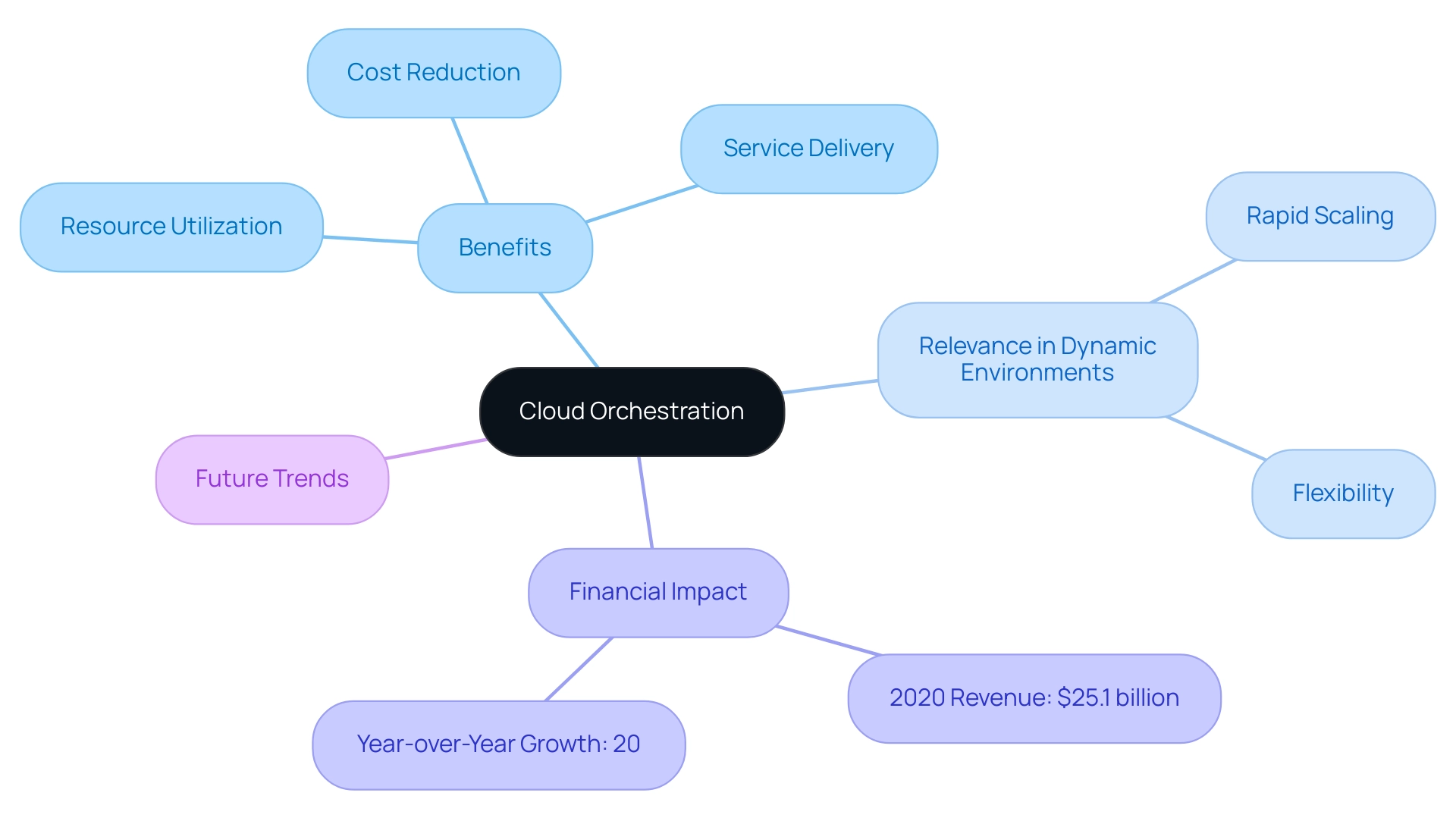
Cloud Orchestration vs. Cloud Automation: Understanding the Differences
Automation and coordination are both essential for effective environment management, yet they fulfill distinct roles. Cloud automation is primarily concerned with the execution of individual tasks autonomously, such as provisioning resources or scaling applications without human oversight. On the other hand, orchestration in cloud manages a series of automated tasks to accomplish a broader objective, such as deploying a complete application stack.
This relationship positions automation as a subset of coordination, where various automated processes are integrated to deliver comprehensive solutions tailored to organizational requirements. Based on recent patterns, half of the businesses surveyed now view online data storage as a crucial element of their data protection approach, further emphasizing the necessity for efficient coordination and automation methods. Significantly, North America was the largest area in the digital management market in 2023, emphasizing its importance in the worldwide context.
Additionally, as noted by Gartner:
- While AWS dominated IaaS with a 38.9% market share in 2020/2021,
- GCP’s IaaS offering grew by 63.7%, indicating a competitive shift within the industry.
This growth is exemplified by Google Cloud's IaaS success, which positions it as a significant player in the market. As organizations navigate these complexities, grasping the subtle distinctions and interconnections between automation and coordination becomes essential for driving agile transformation and optimizing resource management in the digital environment.
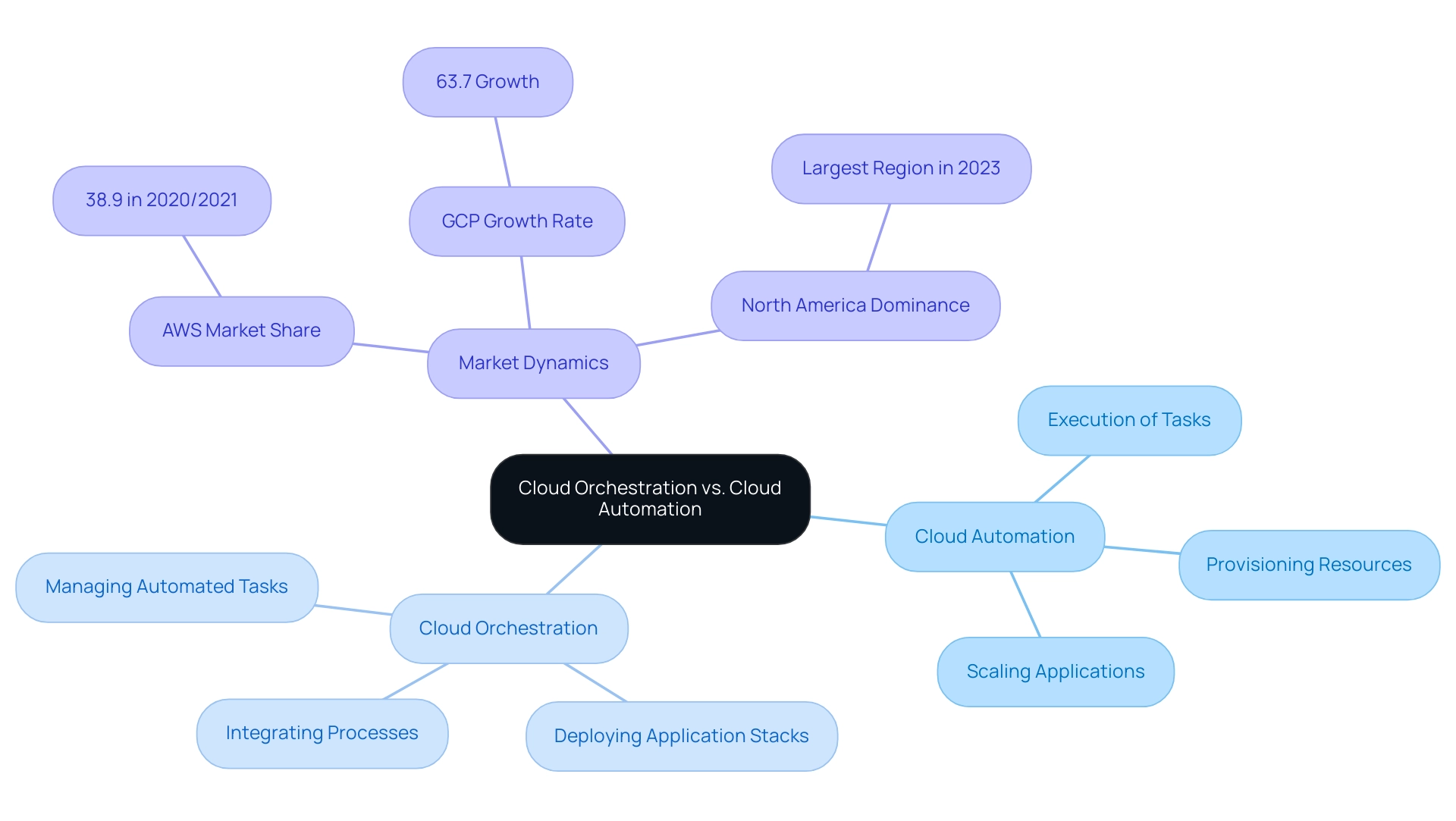
The Importance of Cloud Orchestration in Modern IT
In today's swiftly changing digital environment, orchestration in cloud has become an essential element for organizations aiming to improve their IT processes. By enabling the smooth orchestration in cloud of various online services, management encourages enhanced cooperation among teams and accelerates application deployment. A notable indicator of this trend is Google Cloud's Infrastructure as a Service (IaaS) offering, which experienced a remarkable growth of 63% from 2020 to 2021, highlighting the increasing reliance on online solutions.
Furthermore, orchestration in cloud minimizes manual interventions, thereby reducing the potential for errors and significantly improving operational efficiency. As businesses navigate the complexities of modern markets, the ability to rapidly scale operations through orchestration in cloud becomes vital. This scalability enables organizations to swiftly adapt to market fluctuations and evolving customer needs through orchestration in cloud.
Moreover, the growth of eco-friendly computing, with IT possibly representing 8% of worldwide GHG emissions by 2025, highlights the significance of embracing digital management approaches that not only improve operational efficiency but also encourage sustainable practices. As a result, those who prioritize orchestration in cloud not only improve their deployment speed but are also strategically placed to innovate consistently and sustain a competitive edge in their respective sectors. Case studies, like those recorded in 'Cloud Cost Management Success Stories,' demonstrate how organizations have effectively lowered their costs through various management techniques, emphasizing the practical advantages of these methods.
As highlighted by industry leaders,
Cloud computing is a contemporary data protection strategy
— a testament to how coordination supports both operational resilience and security.
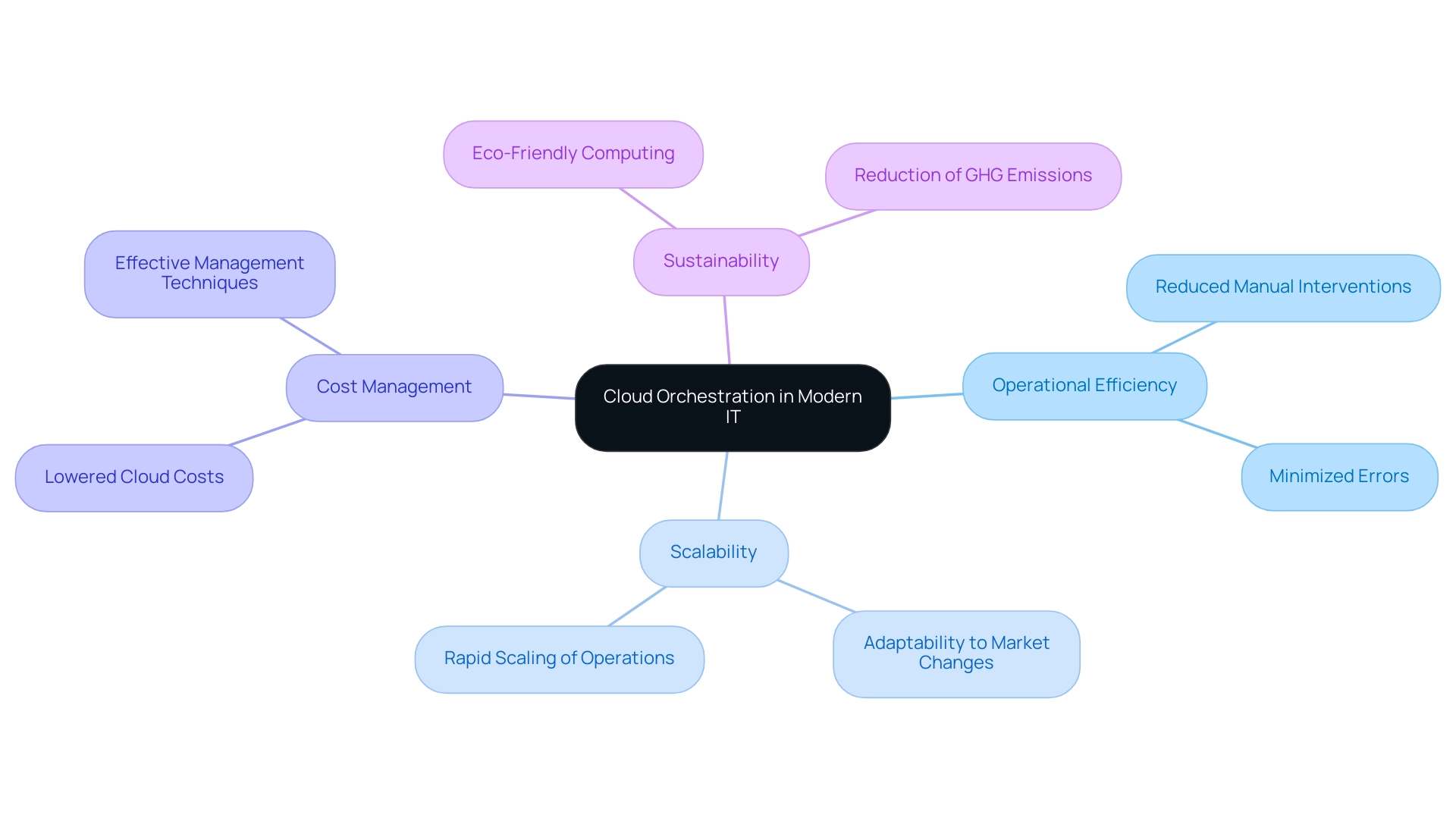
Exploring Cloud Orchestration Models: Options and Strategies
Organizations today have a variety of cloud management models to select from, each customized to specific operational needs and objectives. Among the most notable models are:
- Resource coordination
- Workflow management
The coordination of various components highlights the integration of disparate elements to create a unified application experience, while workflow management concentrates on overseeing and sequencing tasks necessary to complete specific processes, ensuring effective resource utilization at every stage.
As organizations evaluate their deployment preferences, they can choose:
- Hybrid management models that seamlessly integrate on-premises capabilities with online resources
- Multi-provider coordination, facilitating service management across different service providers
Comprehending these various coordination models is essential for organizations seeking to implement the most efficient orchestration in cloud approaches tailored to their specific needs. This knowledge is becoming increasingly essential as the market for network management is expected to expand at a compound annual growth rate (CAGR) of 16% from 2024 to 2033, indicating a shift towards more advanced management strategies across industries.
Additionally, misconfiguration of online platforms is the primary reason for data breaches in digital environments, emphasizing the dangers linked to cloud management and the significance of correct implementation. Furthermore, the recent strategic alliance between Microsoft and AT&T to provide computing services utilizing AT&T’s 5G network infrastructure exemplifies real-world collaboration in this domain. Insights from the 'Cloud Orchestration Global Market Report 2024' further reveal that orchestration in cloud includes various deployment modes, such as private, public, and hybrid, along with diverse end-user sectors like healthcare, transportation, and retail, enriching the understanding of the landscape.
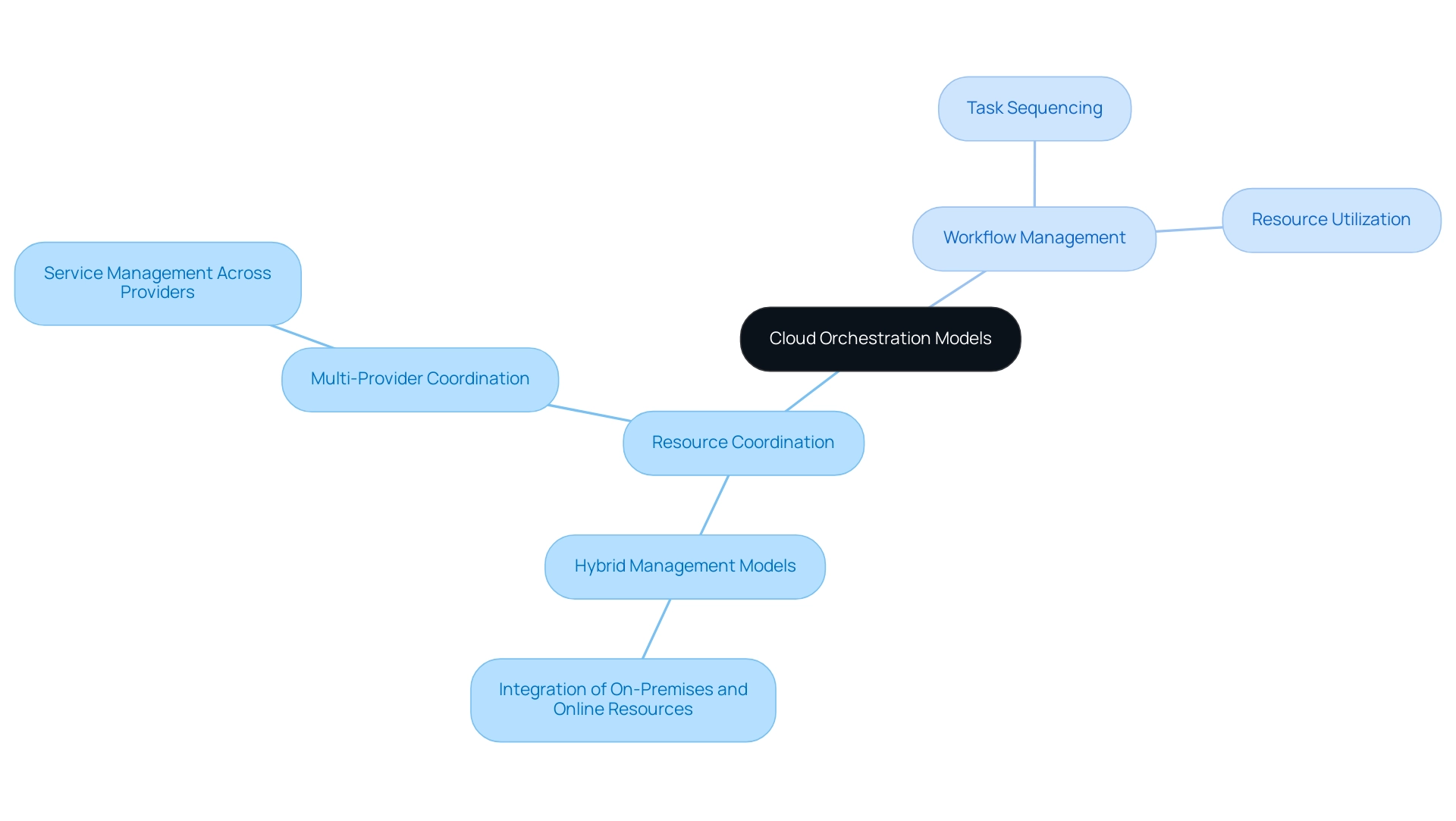
Choosing the Right Cloud Orchestration Platform: Key Features and Considerations
When choosing a computing management platform, organizations must emphasize several vital characteristics to guarantee alignment with their operational requirements and strategic goals. Scalability is crucial, enabling the platform to grow alongside the organization's demands. Equally important is the ease of integration with existing systems, which facilitates a smoother transition and minimizes disruption.
Automation capabilities should be robust, allowing for streamlined processes that enhance efficiency. Furthermore, thorough monitoring and reporting tools are essential for tracking performance and optimizing resource usage efficiently.
Security features must not be neglected, as protecting data and applications during the process is crucial. This is especially significant considering that 94% of enterprises have embraced a hybrid approach mainly to enhance organizational security, underscoring the requirement for management platforms to inherently support such initiatives. Assessing potential platforms in relation to specific organizational requirements, budget factors, and long-term strategic objectives is crucial for effective implementation.
The recent trend indicates that half of surveyed businesses regard online computing as a contemporary data protection strategy. This perspective emphasizes the importance of orchestration in cloud for facilitating disaster recovery and workload migration, thus enhancing organizational resilience. As Cody Slingerland observed,
Together, these two regions represent 82% of the world’s computing.
This statement underscores the necessity for efficient cloud operating models, which are increasingly becoming a minimum requirement for competitiveness.
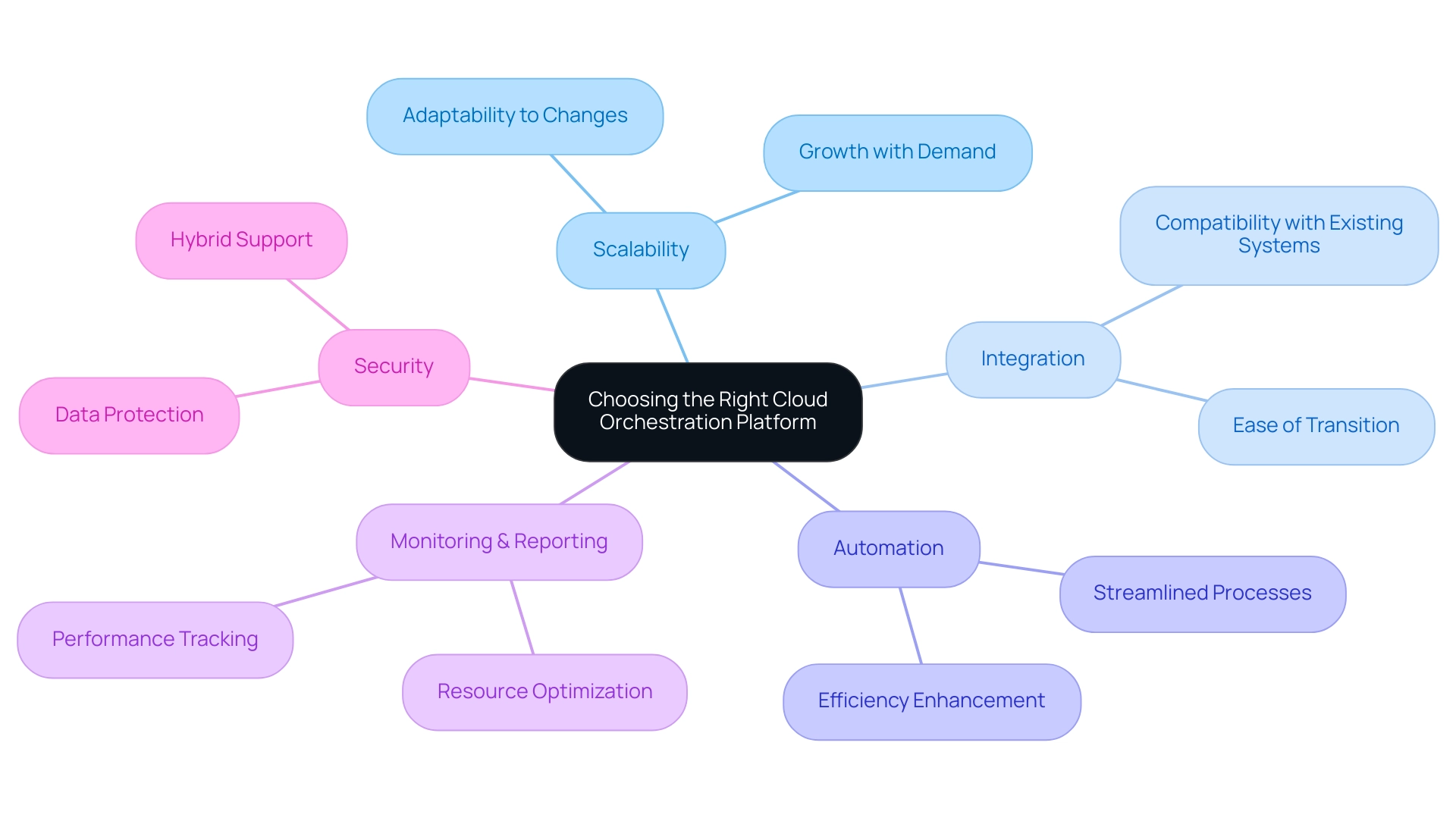
Conclusion
Cloud orchestration represents a transformative approach for organizations aiming to enhance their IT operations and achieve greater efficiency in the cloud. By automating the arrangement and management of complex systems, it not only streamlines the deployment of applications but also optimizes resource utilization across various platforms. The distinction between cloud orchestration and automation highlights the importance of a coordinated strategy that aligns with organizational goals, thereby fostering agility and responsiveness in today's dynamic business environment.
As organizations increasingly adopt cloud orchestration, the implications for scalability, security, and operational resilience become clear. The ability to integrate diverse services while minimizing manual interventions leads to improved collaboration and faster application deployment. Furthermore, the growing emphasis on sustainable practices and the financial impact of effective orchestration solutions underscore its critical role in modern IT frameworks. With the cloud orchestration market poised for significant growth, understanding the various models and selecting the appropriate platform will be essential for organizations striving to maintain a competitive edge.
In conclusion, cloud orchestration is not merely a technical necessity; it is a strategic imperative that empowers organizations to navigate the complexities of the digital landscape. By prioritizing orchestration, businesses can enhance their operational efficiency, adapt swiftly to market changes, and innovate continuously, ultimately positioning themselves for long-term success in an increasingly cloud-centric world.




